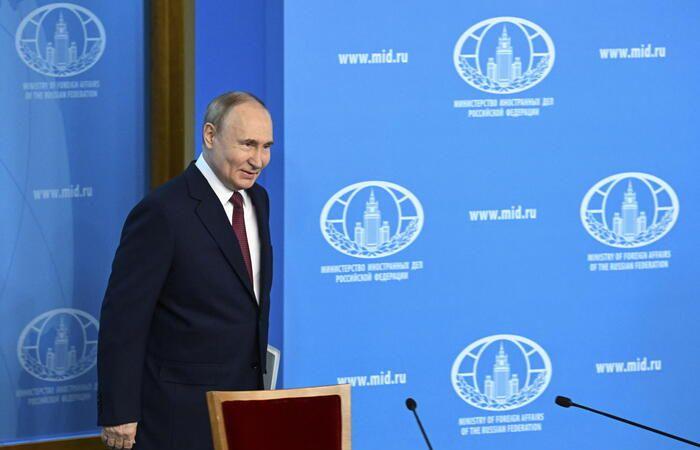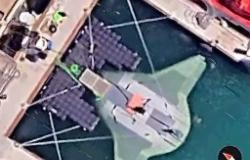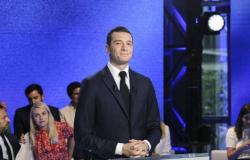After more than two years of conflict, Vladimir Putin puts his cards on the table and for the first time concretely announces what his objectives are in Ukraine. Moscow is ready to cease hostilities and negotiate to sign peace if Kiev withdraws its troops from the four regions partially occupied by Russian troops and renounces joining NATO. A scenario immediately rejected by Ukraine and its Western allies. Putin “cannot be trusted”, President Volodymyr Zelensky said, equating the Russian leader with Hitler. The tsar spoke on the day the G7 summit in Italy assured support for Ukraine “for as long as necessary” and reiterated the need for a peace that respects the country’s “territorial integrity”. The Grandees also expressed their support for the ‘Peace Conference’ which begins tomorrow in Switzerland with the participation of over 90 nations and organizations, to which Russia was not invited. “Another trick – the Russian president defined it – which aims to divert everyone’s attention from the causes of the Ukrainian crisis”. The four regions Putin spoke about – implicitly excluding aims at others, including Odessa – are Donetsk, Lugansk, Zaporizhzhia and Kherson. Of these, only Lugansk is almost entirely controlled by the Russians, who have continued to advance in Donetsk for months. And, evidently confident about the direction the conflict has taken, Putin made it clear that if Kiev does not accept the conditions set, its situation on the ground is destined to worsen. The president’s proposals reflect the current situation, but Kiev should keep in mind that circumstances may change, Kremlin spokesman Dmitry Peskov stressed. “Today we are making a real peace proposal, we are talking not about freezing the conflict but about its total cessation,” Putin said, speaking to Foreign Ministry officials for the first time since 2021. As soon as Kiev begins the withdrawal of troops and announces its renunciation of joining NATO, “in the same minute the order will be given to cease fire and begin negotiations”, assured the president. The negotiations should lead to “international agreements” which also establish the “cancellation of all Western sanctions against Russia”. “It’s the same thing Hitler did, when he said ‘give me a part of Czechoslovakia and that’s the end of it,’” Zelensky responded. “But afterwards – he added – there was Poland, then the occupation of all of Europe. That’s why we shouldn’t trust these messages, because Putin follows the same path. Today he talks about four regions, before he talked about Crimea and Donbass”. This, the Ukrainian leader added, is “the new face of Nazism”.
“Putin has illegally occupied sovereign Ukrainian territory and is in no position to dictate to Ukraine what it must do to bring peace,” commented US Defense Secretary Lloyd Austin. While for the general secretary of NATO, Jens Stoltenberg, that of the Russian leader “is not a proposal for peace, it is a proposal for greater aggression and greater occupation”. “It is not up to Ukraine to withdraw forces from Ukrainian territory, it is up to Russia to withdraw its forces from occupied Ukrainian territory,” added the representative of the Atlantic Alliance. Putin also commented on the possibility of confiscating part of the Russian assets frozen in the West in favor of Ukraine, stating that it would be “a theft that would not go unpunished”. While the spokeswoman of the Foreign Ministry, Maria Zakharova, defined the bilateral security agreement signed yesterday between Zelensky and US President Joe Biden on the sidelines of the G7 summit as only “a piece of paper” that “has no legal value”. Meanwhile, Russian regions close to the border continue to be targeted by attacks by Ukrainian forces, as reported by their respective governors. In Kursk one person died and two were injured. In Belgorod, five people were injured in the partial collapse of a building hit by a bomb in the town of Shebekino. The Defense Ministry said that on the night between Thursday and Friday, 87 Ukrainian drones were shot down over various Russian regions, including 70 in Rostov.
Video Russia, Putin: ‘The freezing of our capital is theft’
Video Putin: ‘The summit in Switzerland? Just a trick’
“No one has any idea how many Israeli hostages are still alive.” The words of Osama Hamdan, Hamas representative in Beirut, sound like yet another push against the hopes of a truce in the war in Gaza. Hopes that for weeks have focused on the plan supported by the USA for an agreement on the ceasefire and the release of the kidnapped, which fails to find a solution due to the position of the Palestinian militiamen, defined by US President Joe Biden at the G7 as “the most great obstacle” to the agreement. While the Israeli offensive on Rafah continues in the Strip and tensions in the north with Lebanon continue, from where Hezbollah attacks continue with dozens of rockets on the Upper Galilee.
In addition to the obscure declarations on the fate of the hostages captured on October 7, Hamdan reiterated in an interview with CNN the position of Hamas on the ceasefire proposal promoted by the United States and supported by a resolution of the UN Security Council: the Palestinian group needs “a clear position from Israel to accept the ceasefire, a complete withdrawal from Gaza and let the Palestinians determine their own future, reconstruction. Then we will be ready to talk about a fair agreement on prisoner exchange”.
Hamdan’s comments are the clearest public signal yet of Hamas’s position, which has remained largely unchanged in recent failed negotiations. And as the days pass, concern grows that the turning point in the negotiations hoped for by the West may not arrive, while the G7 expressed support for Biden’s plan and “reiterated its appeal to Hamas to accept the proposal” to cease the fire. “The biggest obstacle is that Hamas refuses to sign”, said the American president, underlining that now, “it remains to be seen whether the agreement will materialize or not”.
If the optimism about the agreement fades, the war continues in the Strip, where the Israeli assault on Rafah and the bombings in the center of the enclave continue, while UNRWA accuses Israel of preventing the delivery of aid to the Palestinian population. But it is Israel’s northern border that now focuses fears of an escalation: Hezbollah’s launch of dozens of rockets on the northern territories of the Jewish state continues. According to the IDF, the Shiite group launched 35 rockets on the territories of Kiryat Shmona and the community of Kfar Szold.
Some were intercepted while anti fell causing damage and fires. In response, the Israeli army claimed to have struck Hezbollah positions.
The tensions worry the G7, and in an attempt to resolve the crisis, French President Emmanuel Macron has evoked “an Israel-USA-France trilateral to carry forward the road map” proposed by Paris to ease tensions. A perspective abruptly rejected by Defense Minister Yoav Gallant according to whom France “has adopted hostile policies against Israel” and “ignores the atrocities committed by Hamas”. But Gallant’s utterances are not shared by the entire Netanyahu government, and they were not liked by the Foreign Ministry of the Jewish State, which “disapproved” of the defense chief’s words, calling them “inappropriate”. And remembering the active role played by Paris in defense of Israel and against anti-Semitism.
Reproduction reserved © Copyright ANSA





